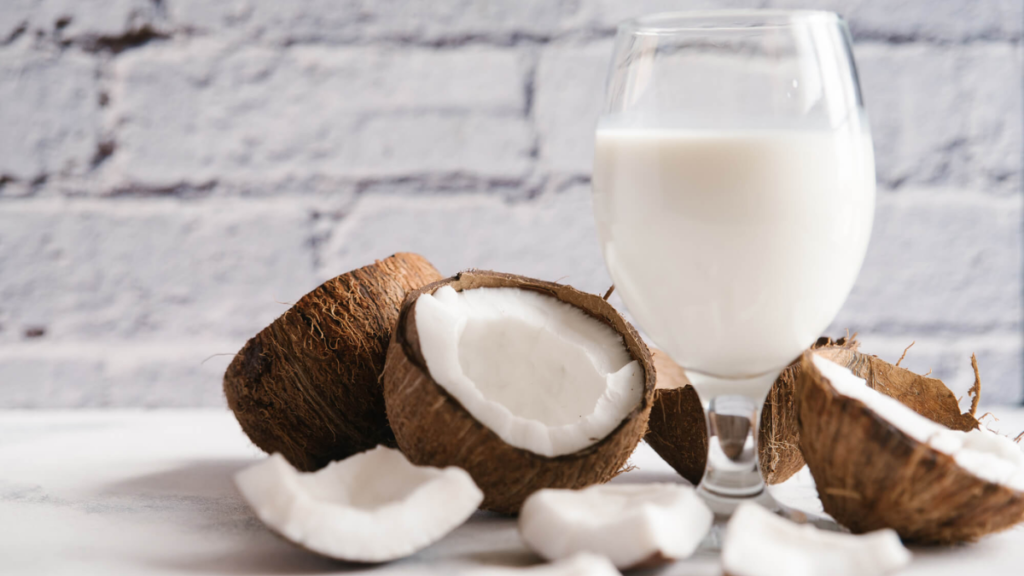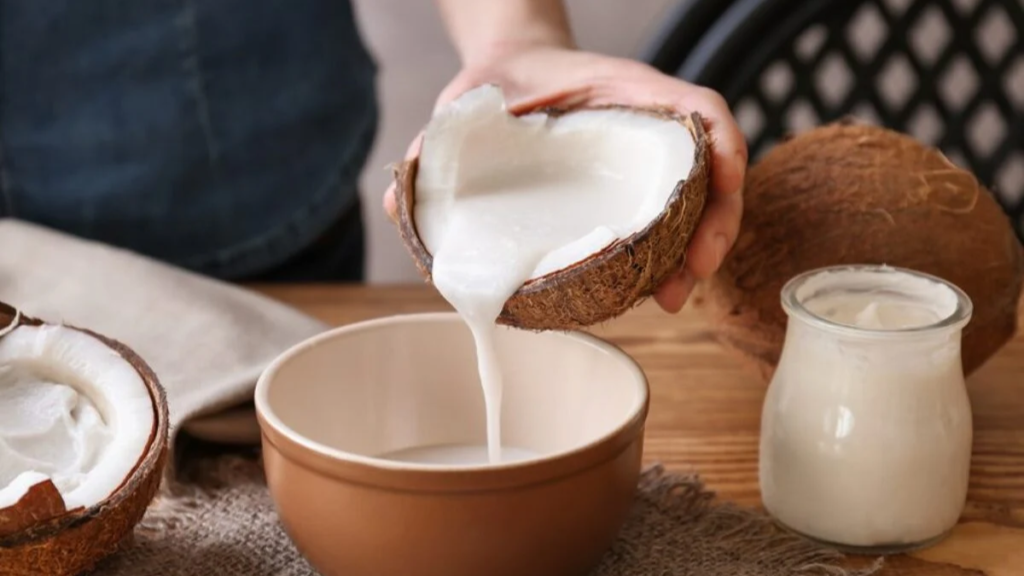Milky White Coconut Milk is used as a culinary foundation or as a flavoring element in many recipes. Coconut’s high oil content is responsible for its rich and creamy texture. Any seafood preparation is transformed into a mouthwatering dish with this oil-rich milk. Coconut milk is thick, creamy vegetable milk with a delicious flavor. It simply takes two ingredients and 5 minutes to prepare; it’s quick, flavorful, and delicious!
It can be used as a dairy substitute if you’re allergic to lactose or casein, and it has a long history of use in Asian and South Pacific cuisines. Coconut milk is simple to prepare at home, and the technique is the same for both commercial and handmade varieties.
Coconut Milk Nutrition Facts
What is Coconut Milk?
Coconut milk is a clear, white liquid obtained by extracting the meat of a mature coconut. Coconut milk is traditionally made by shredding coconut meat, combining it with boiling water, and pressing the liquid through a cheesecloth. Coconut cream results from this process, which is a thick, fatty liquid. Coconut cream can be processed further to produce coconut oil or pressed to produce coconut milk. Commercially processed coconut milk—the kind you’ll find in cans at the supermarket—is mechanically grated and pressed, and it’s sometimes stabilized with guar gum.
How is it Made?
Coconut milk is simple to prepare at home, and the technique is the same for both commercial and handmade varieties. To extract the milk, separate the coconut flesh from the husk by shredding or mixing it into tiny bits with water, then squeeze and drain the meat and water mixture.
- Traditionally, you split a brown coconut and then scrape away and reserve the white flesh, mixed with water, squeezed, and strained.
- Commercial coconut milk is prepared through mechanized production, which involves separating the white flesh from the husk and grating or pressing it to extract the milk. Additives such as gums and preservatives are often added to the liquid before being canned.
- To make it at home with fresh coconut, you can follow the traditional method by using a coconut scraper or prying the white flesh from the coconut husk and blending it with water in a high-speed blender before straining and serving.
- To make it at home with dried coconut, you’ll blend the dried coconut with hot water in a blender and then strain and serve.
How to Make Coconut Milk?
Homemade coconut milk is produced using only two ingredients! Creamy, naturally sweet, and the ideal dairy-free milk substitute!
Ingredients
- 2 cups (~160 g) shredded unsweetened coconut
- 3-4 cups (720-960 ml) water (use less water for thicker, creamier milk!)
- Pinch salt
- optional: 1 date or 1 Tbsp (15 ml) maple syrup for sweetness
- optional: 1/2 tsp vanilla extract
- optional: 2 Tbsp (10 g) cocoa or cacao powder for chocolate “milk” or 1/4 cup fresh berries for berry “milk”
Instructions
-
Add coconut, 3 cups (720 ml) water, salt, and any additional add-ins (optional) to a high-speed blender. Top with lid and cover with a towel to ensure it doesn’t splash. Blend for about 2 minutes or until the mixture seems well combined.
-
Scoop out a small sample with a spoon to test flavor/sweetness. Add more dates, salt, or vanilla as needed. Add remaining 1 cup (240 ml) water if too thick.
-
Pour the mixture over a large mixing bowl or pitcher covered with a nut milk bag, a thin towel, or a clean T-shirt. In my experience, it benefits from a single strain either through a thin towel or a nut milk bag. You can save pulp for baked goods or add it to oatmeal, smoothies, or energy bites.
-
Transfer to a sealed container and refrigerate. Will keep in the refrigerator for up to 5 days (sometimes more). Enjoy cold or hot and shake before use, as it can separate in the refrigerator (due to no preservatives!). It can be used in smoothies, with granola, for golden milk, matcha lattes, or baked goods.
Tips for Making Coconut Milk
Here are some tips for making coconut milk:
- Use mature brown coconuts and reserve young green coconuts for making coconut water and coconut yogurt. It also has a fresher, richer flavor than
- Use hot water to extract the coconut’s beneficial oils more efficiently, resulting in richer flavor and texture.
- Remove the tough husk, but leave a small amount of the brown hull. The flavor and texture of the fresh coconut meat are unaffected by the thin covering of the brown shell that surrounds it.
- If you make it regularly, invest in a coconut grater and a coconut drill. They’re super affordable and the traditional tools of choice.
What are the Health Benefits of Coconut Milk?
Here are the health benefits of coconut milk:
Contains Medium-Chain Fatty Acids
Coconuts have a lot of fat, but unlike other nuts, it’s mainly in medium-chain saturated fatty acids (MCFAs) like lauric acid. This means that the fatty acids in coconut oil have a chain of six to twelve carbon atoms instead of the more than twelve found in long-chain fatty acids. This structural variation has a variety of ramifications, ranging from how coconut milk fat is digested to how it may affect your body.
Is Lactose-Free
Unlike cow’s milk, coconut milk is lactose-free and can be used as a milk substitute by people who are lactose intolerant. Lactose is the primary carbohydrate found in all mammalian milk, including that of humans, goats, and sheep. It’s made up of two sugars, and your body needs the enzyme lactase to digest it properly. A deficiency causes lactose intolerance in this enzyme. Vegans love coconut milk because it’s an excellent base for smoothies and milkshakes, and it can also be used as a dairy substitute in baking.
Has Anti-Inflammatory, Anti-Microbial, and Anti-Fungal Properties
About half of the MCFAs in coconut oil is lauric acid, which is metabolized in the body into monolaurin, a highly effective antibacterial, antifungal, and anti-inflammatory molecule that kills a wide range of disease-causing organisms. As a result, it’s claimed that drinking coconut milk and eating other coconut-derived foods can help the body fight infections and viruses.
May Support Cardiovascular Health
Because MCFAs are readily metabolized into energy in the liver, they are used up more quickly by the body and are less likely to be stored as fat than other saturated fats. Although the evidence is contradictory, several recent research suggests that coconut fats may not have the same negative impact on blood lipids, cholesterol balance, and cardiovascular health as previously thought. This is an area of research to keep an eye on.
May Reduce Stomach Ulcers
Coconut milk reduced the growth of a stomach ulcer by the same amount as an anti-ulcer medication in animal research. Further research confirms that this is due in part to the anti-inflammatory qualities of milk and its favorable effects on mucosa growth.
Is Coconut Milk Safe for Everyone?
Coconut allergy symptoms are uncommon, although contact dermatitis and sensitization to tree pollen are more common. Coconuts are one of those meals that straddle the line between ‘good‘ and ‘bad.’ Coconut milk, particularly low-fat varieties, can be consumed in moderation (up to two times per week).
Conclusion
In tropical cuisines and vegan baking, coconut milk is a must-have ingredient. Coconut milk can be purchased, but it’s also relatively simple to make at home—and you might already have the ingredients on hand. Coconut milk is a creamy, sweet, and delectable beverage. It has a light coconut flavor and tastes fresher than canned coconut. While dried coconut meat can create coconut milk, utilizing a fresh brown coconut is worth the effort because the flavor is better.
Coconut milk is traditionally made by shredding coconut meat, combining it with boiling water, and pressing the liquid through a cheesecloth. Coconut cream results from this process, which is a thick, fatty liquid. Coconut cream can be processed further to produce coconut oil or pressed to produce coconut milk.




